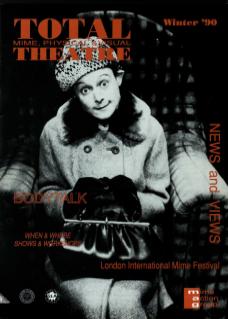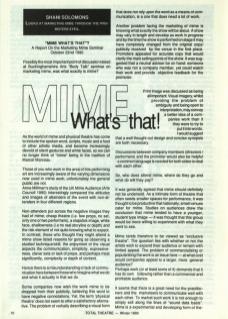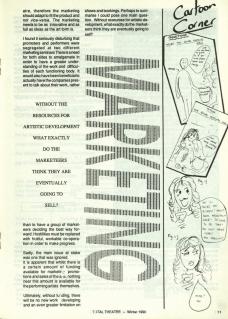Possibly the most important point of discussion raised at Buckinghamshire Arts' ‘Body Talk’ seminar on marketing mime was, What exactly is mime?
As the world of mime and physical theatre has come to include the spoken word, scripts, music and a host of other artistic media, and become increasingly devoid of silent gestures and white faces, we can no longer think of ‘mime’ being in the tradition of Marcel Marceau.
Those of you who work in the area of this performing art are increasingly aware of the varying dimensions now used in mime work; unfortunately the general public are not. Anne Millman’s study of the UK Mime Audience (Arts Council 1990) interestingly compared the attitudes and images of attenders of the event with non-attenders in four different regions.
Non-attenders put across the negative images they had of mime: cheap theatre (i.e. few props, no set, only one or two performers), a slapstick image, white face, shallowness (i.e. no real storyline or depth), and the risk element of not quite knowing what to expect. In contrast, those who thought they might attend a mime show listed reasons for going as observing a studied technique/skill, the enjoyment of the visual aspects the communication, simplicity, expressiveness, clever sets or lack of props, and perhaps most significantly, complexity or depth of content.
Hence there is a misunderstanding or lack of communication here between those who imagine what we do and what it actually is that we do.
Some companies now wish the word mime to be dropped from their publicity, believing this word to have negative connotations. Yet, the term ‘physical theatre’ does not seem to offer a satisfactory alternative. The problem of verbally describing a visual form that does not rely upon the word as a means of communication is one that does need a lot of work.
Another problem facing the marketing of mime is knowing what exactly the show will be about. A show may vary in length and develop as a work in progress, and by the time the show is performed on stage it may have completely changed from the original publicity copy received by the venue in the first place. Promoters appealed for accurate copy that would clarify the main selling points of the show. It was suggested that a neutral adviser be on hand: someone who was not a company member, yet could watch their work and provide objective feedback for the promoter.
Print image was discussed as being all important. Visual imagery, whilst providing the problem of ambiguity and being open to interpretation, may convey a better idea of a company’s work than if they were to try to put it into words. I would suggest that a well thought-out design and concise synopsis are both necessary.
Discussions between company members (directors/performers) and the promoter would also be helpful – a common language is needed for both sides to deal with each other.
So, who does attend mime, where do they go and what do they pay?
It was generally agreed that mime should definitely not be undersold. As an intimate form of theatre that often needs smaller spaces for performance, it was thought to be productive that, nationally, small venues cater for mime. Studies on audiences drew the conclusion that mime tended to have a younger, student type image – it was thought that this group would be more willing to experiment with what they went to see.
Mime tends therefore to be viewed as ‘exclusive theatre’. The question lies with whether or not the artists wish to expand their audience or remain with limited appeal. The problem of commercialising or popularising the work is an issue here – at what cost would companies appeal to a larger, more general audience? Perhaps work (or at least some of it) demands that it has its own following rather than a commercial and profitable audience.
It seems that there is a great need for the practitioners and the marketeers to communicate well with each other. To market such work it is not enough to simply sell along the lines of ‘sound data basis’. Mime is an experimental and developing form of theatre, therefore the marketing should adapt to fit the product and not vice versa. The marketing needs to be as innovative and as full as ideas as the artform is.
I found it seriously disturbing that promoters and performers were segregated at two different marketing seminars. There is a need for both sides to amalgamate in order to have a greater understanding of the work and difficulties of each functioning body. It would also have been beneficial to actually have the companies present to talk about their work, rather than to have a group of marketeers deciding the best way forward. Hostilities must be replaced with fruitful, workable cooperation in order to make progress.
Sadly, the main issue at stake was one that was ignored. It is apparent that whilst there is a certain amount of funding available for marketing promotions and sales of the arts, nothing near this amount is available for the performing artists themselves.
Ultimately, without funding, there will be no new work developing and an even greater limitation on shows and bookings. Perhaps to summarise I could pose one main question. Without resources for artistic development, what exactly do the marketeers think they are eventually going to sell?


